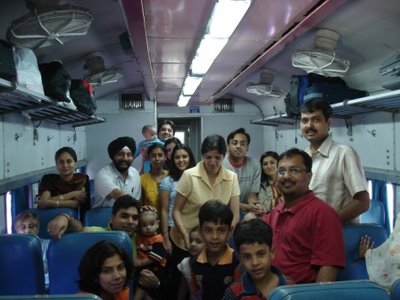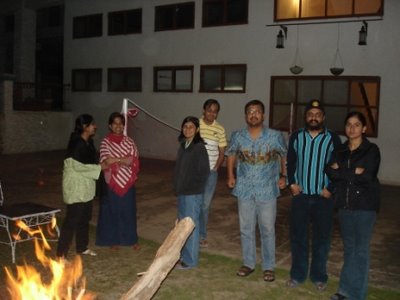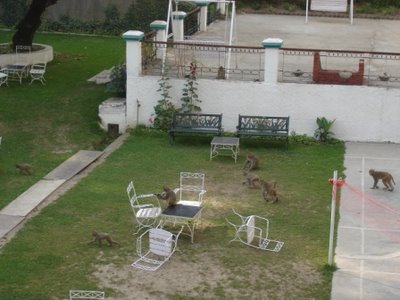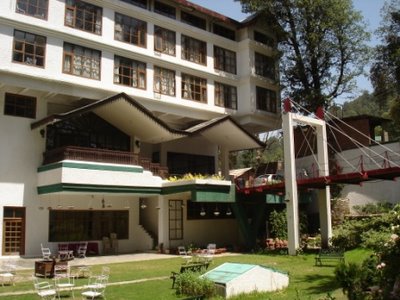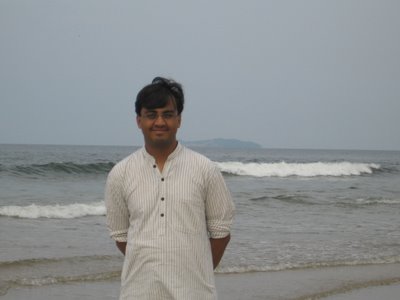We started the next day again with a walk on the beach. We even dared to venture into the water. I use “dared” because the water was rough (as I mentioned earlier) and neither of us knows swimming. There was no life guard, in fact there was no other soul on the beach. We had the whole stretch of the beach to ourselves - it was beautiful :-))
 Testing the waters
Testing the waters
In the second half of the day, the resort people had organized a sight-seeing tour for the guests who had arrived in last 2-3 days. So, we decided to visit some of the nearby beaches in the morning, and headed for Colva.
As we drove, we discovered the biggest advantage of having a two wheeler by means of conveyance. We traveled on the internal roads through the villages, enjoying the “real” landscape of Goa. We took a detour whenever we saw a road or lane that looked promising, and in this way we “discovered” many lovely old mansions, pretty houses, quaint churches, and ponds covered with red and white water lilies.

Somewhere...
The beach at Colva had quite a few visitors, and had some basic infrastructure like lifeguard station (no lifeguard in sight though!). The day was sunny and the sea looked a nice blue, just a little bit darker than the clear blue sky.

Colva
Colva is one of the better known sites for water sports. However, since the tourist season had not yet started at the time of our visit, there was not much activity. There was just one parasailing organizer .

Parasailing (No, it isn’t either of us)
We stayed there for a little while before starting back for the hotel.

The bike, the rider and orange flowers
After lunch and a short rest, it was time for the sight seeing tour. I am not a fan of such tours, but the tour included two items that looked really exciting – a visit to Old Goa, and a cruise on the Mandovi river in the moonlight (but both of these turned out to be big fiasco, as we learnt only later! – hindsight wisdom ?!!).
The resort people had arranged a bus for the tour. The bus was not in a very good condition, and had barely enough seats. The guide initially tried to amuse people (with little success), but gave up after some time. It had started raining by the time we reached our first stop, Old Goa. What we visited was not the ancient part of the state, as one might imagine (at least we did), but a kind of museum, which used mannequins and other props to show how Goans lived in old times. It depicted the kinds of huts and equipment different craftsmen used. We did not find this museum particularly appealing. The only thing that interested us was an image of Meerabai carved in Laterite. The image, which is more than 10 m long and 6 m wide, was carved by one man using only basic tools, in a month.

Meera
While we were still there, it started raining very heavily; and since the entire area was essentially open, movement became difficult, delaying our departure. We took shelter in a stretch of path covered with a canopy, and looked like a cave, but with leaks!!
The next stop was at Mangueshi temple, in the village by the same name. It is the hometown of the famous singers Lata Mangeshkar and Asha Bhonsle. The temple is dedicated to Lord Shiva and Parvati. The uniqueness of this temple is that this is the only place in India where Lord Shiva is depicted with a beard. When our guide told us so, we had to strain our mind to realize that we have indeed never seen a picture or idol of Shiva with a beard. The legend has it that Shiva came down here to relax from his Himalayan abode – hence the beard. Wow! Interesting!!

Lord Shiva with a beard
Next we went to St. Fracis Xavier Church in Panjim. By the time we reached there, the rain had stopped, but it was still cloudy, making the weather very pleasant. The guide informed us that we were not allowed to wear caps and sunglasses inside. We could take the camera, and even take pictures inside the church, though not of people. This came as a bit of surprise, as we have not been allowed to take cameras inside most of the famous temples anywhere in India, or not allowed to take pictures, if we could take the camera, for many years. In the church is kept the body of St. Francis Xavier, for last 400 years or so. A wonderful story is associated with it. Here is the story, as it was told to us (I later found that some of the facts were not so accurate). After working in India, St Francis traveled to China, but died during the journey. His body was brought back in a coffin to Goa, as he wished to be buried here. When the coffin was opened, the body was found to be intact, two years after his death. A message was sent to Rome, and a special coffin for his burial requisitioned. It took four years for the new coffin to arrive, and when the older one was opened to transfer the body, there were still no signs of decomposition! It has since been in the church, in a glass box in a coffin. Every ten years, it is opened for airing, and for public view. It is said that the body has not decayed at all, in all this time, though it is not embalmed with any preservatives. It is shrinking though, and they say that when it disappears, the world will come to an end. Amazing story, if I ever heard one. (However, given the rate with which it is shrinking, the world is safe for a few thousand years, unless it is destroyed before that by the unscrupulous ways of humans). :-))
 Mortal remains of St. Francis Xavier
Mortal remains of St. Francis Xavier
Yet another story is associated with this church, though I did not make any effort to determine its authenticity. All churches have a cross at the top, this one is an exception. It is said that the church authorities tried to put up the cross several times, but it kept falling off . The reason is believed to be a curse, as the Portugese had demolished a temple that stood at this site, to construct the church. The cross now stands on a pillar a few meters away from the church building.

St. Fracis Xavier Church
We spent quite some time at the church, appreciating the golden décor, seeing old oil paintings on the walls of some of the rooms, and taking pictures. It was almost dark when we left, and proceeded to the bank of Mandovi river for the cruise.
At a point near the mouth of the river (Panjim lies on the banks of Mandovi, where it meets the sea), a large number of “cruise operators” were running shop. There were huge crowds, and long queues (and quite a bit of jostling) to board the “ship”. The “ships” were essentially larger boats, were embellished with lot of lights, and played loud music. After a long wait, we finally boarded our ship, and were directed to the deck. Our hearts sank at the sight we saw. The deck was covered with tarpaulin (hey! This was supposed to be a moonlight cruise !! Where do we see the moon from ?!). Whole the floor space was packed with plastic chairs – as many as possible – leg space and aisles seemed to be an alien concept to them. There was just a little space in the front for the performers, and a snack counter at the back. A little while after the ship started sailing (it sailed upstream into the river), the performers took the stage. The performance consisted of hindi, Punjabi and goan songs, sung tunelessly for most part. What they lacked in the melody, they made up in the volume – the ensuing noise was ear-shattering. We put up with it for few minutes, before going to the lower deck. It did not have fancy lightings or seating arrangement, but was quiet, and provided a view of the river, the lighted buildings on the bank, and other ships sailing on the river. We stayed here for the entire journey which lasted one and a half hours, and watched a lot of other people come down too as it progressed.

Panjim by night
I must say that we did get some pretty views of Panjim by night-time, but we couldn’t capture good pics from the boat in the night. And I would definitely avoid another such cruise, if I ever go there again.
On the way back to the resort, the bus stopped in the market, and the guide referred a “reliable” shop, if people were interested in purchasing ‘Kaju Feni’ (Cashew Wine) and salted Cashews, that Goa is extremely famous for. We passed up on the offer, and wondered if the guide got a fat commission from the shop owner.


















